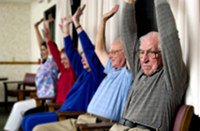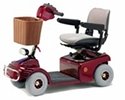
Exercises for the Elderly
Information, Resources and Recommendations
Exercises for the elderly are an important part of maintaining a healthy lifestyle.
They have significant benefits for seniors' physical and mental health.
Exercises for the elderly is an important part of a healthy lifestyle.
Staying physically active and exercising regularly can help prevent or delay many diseases and disabilities, including dementia.
Seniors hurt their health far more by not exercising than by exercising. Decreased mobility, poor strength and endurance just to name a few.
Exercises for the elderly have physical and mental benefits - and for some people the mental benefits are actually more valuable!
Physical Benefits
An inactive lifestyle can cause elderly to lose ground in four areas that are important for staying healthy and independent: strength, balance, flexibility, and endurance.
Muscle mass decreases as we age. Beginning in the fourth decade of life, adults lose 3%-5% of muscle mass per decade, and the decline increases to 1%-2% per year after age 50. Muscle keeps us strong, it burns calories and helps us maintain our weight, and it contributes to balance and bone strength. Without it, we can lose our independence and our mobility.
Exercises for the elderly improves your sleep. Poor sleep is not an automatic consequence of aging and quality sleep is important to your health. Exercise can improve sleep, helping you fall asleep more quickly and sleep more deeply.
Mental Benefits
Exercise boosts mood and self-confidence. Endorphins produced by exercise can actually help you feel better and reduce feelings of sadness or depression. Being active and feeling strong naturally helps you feel more self confident and sure of yourself.
Exercise is good for the brain. Exercise benefits regular brain functions and can help keep the brain active, which can prevent memory loss, cognitive decline, and dementia. Exercise may even help slow the progression of brain disorders such as Alzheimer's disease.
Examples of Exercises for Elderly
Elderly should only do the exercises (listed below) that they feel comfortable doing.
These are excellent exercises for the elderly specifically recommended to older adults, seniors and the elderly.
They can help prevent falls by improving strength, endurance, flexibility and balance.
Work them into your (or your aging parents) daily routine. They take only a few minutes but can greatly improve the seniors mobility.
Slow Toe Taps
- Stand facing a countertop. Hold on with both hands.
- Keep heels on floor and lift toes up. Hold. Relax.
- Repeat with the other foot.
- Alternate. Complete 3-5 for each foot.
- Build up to the point where you can do this for 2 minutes.
- Gradually decrease the amount of support you place through your hands.
Up On Toes
- Stand facing a countertop. Hold on with both hands.
- Rise up on toes with both feet.
- Come down slowly.
- Repeat 3-5 times.
- Build up to the point where you can do this 15 times.
- Gradually decrease the amount of support you place through your hands.
Mini Squats
- Stand facing a countertop. Hold on with both hands.
- With feet apart, bend knees slightly. Keep heels on the floor.
- Do not bend too far.
- Hold for a few seconds.
- Stand up.
- Repeat 3-5 times.
- Build up to the point where you can do 15.
- Gradually decrease the amount of support you place through your hands.
Walking On The Spot
- Stand facing a countertop. Hold on with both hands.
- Walk slowly on the spot for 15 seconds.
- Build up to the point where you can do this for 2 minutes.
- Walk in your home for 3-4 minutes using a mobility aid if you use one (walker, cane).
- Increase your time by 1 minute every 3-4 days.
Alternate Leg Out And In
- Stand facing a countertop. Hold on with both hands.
- Keeping toes pointing forward, lift one leg out to the side.
- Hold and then slowly lower leg.
- Repeat with other leg.
- Continue until you have done 3-4 on each side.
- Build up to the point where you can do 15 on each leg.
- Gradually decrease the amount of support you place through your hands.
Alternate Leg Behind
- Stand facing a countertop. Hold on with both hands.
- Lift one leg behind you, keeping knee straight.
- Return to starting position.
- Repeat with other leg.
- Continue to alternate legs, repeating 3-5 times each.
- Build up to the point where you can do 15 on each leg.
- Gradually decrease the amount of support you place through your hands.
Sit To Stand
- Sit in a sturdy chair with arm rests. Position mobility aid (walker, cane) if needed.
- Bring bottom to front of chair and legs closer to chair.
- Lean forward and stand up.
- Stand for a few seconds and then slowly sit back down.
- Stand up and sit down 3-5 times.
- Build up to the point where you can do 15. Add one more every few days.
- Gradually decrease the amount of weight you put through your arms until you can do it just with your legs.
Exercise Activities
In addition to the exercises for the elderly listed above, it's also important to participate in regular activities that have health benefits.
This includes:
- Walking - Walking is a perfect way to start exercising. It requires no special equipment, aside from a pair of comfortable walking shoes, and can be done anywhere.
- Senior sports or fitness classes - Keeps motivation alive while also providing a source of fun, stress relief, and a place to meet friends.
- Water aerobics and water sports - Working out in water is wonderful for seniors because water reduces stress and strain on the body's joints.
- Yoga - Combines a series of poses with breathing. Moving through the poses works on strength, flexibility and balance. Yoga can be adapted to any level.
- Tai Chi and Qi Gong - Martial arts-inspired systems of movement that increase balance and strength. Classes for seniors are often available at your local YMCA or community center.
Return to Caring for Aging Parents






New! Comments
Have your say about what you just read! Leave me a comment in the box below.